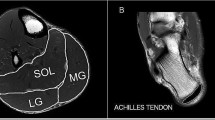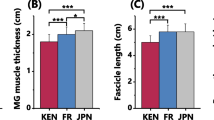Abstract
The present study examined the cross-sectional area (CSA) of the Achilles tendon in subjects who repeatedly exposed their tendons to large loads (habitual runners) compared to control subjects (non-runners). Six male habitual runners [36 (7) years, 70.9 (4.4) kg and 1.84 (0.05) m, ±SD] who had performed distance running (~80 km per week) for the last 5 years were compared to six non-runners [34 (3) years, 81.2 (8.7) kg and 1.81 (0.02) m, ±SD]. Tendon CSA was obtained from MR images obtained with the ankle in a neutral position (90°). The most proximal aspect of the tuberosity of calcaneus was used as a landmark to standardize the levels of images: the most distal image (1) was obtained 10 mm above the proximal tuberosity of calcaneus, and the most proximal image (7) was obtained 70 mm above the proximal tuberosity of calcaneus. There was a significant difference in CSA along the length of the tendon both in runners (P<0.001) and non-runners (P<0.01). In non-runners and runners the CSA of the most distal part was 51% and 85% greater than the most proximal part of the tendon, respectively. Furthermore, there was a difference in tendon CSA between the groups, such that runners had a greater CSA (36%) than non-runners at the most distal part of the tendon (P<0.05). The greater CSA in the distal tendon may reflect differences in structural properties along the length of the human Achilles tendon, while the greater CSA in runners compared to non-runners may indicate a region-specific hypertrophy in response to the habitual loading of running.


Similar content being viewed by others
References
Birch HL, McLaughlin L, Smith RK, Goodship AE (1999) Treadmill exercise-induced tendon hypertrophy: assessment of tendons with different mechanical functions. Equine Vet J Suppl 30:222–226
Buchanan CI, Marsh RL (2001) Effects of long-term exercise on the biomechanical properties of the Achilles tendon of guinea fowl. J Appl Physiol 90:164–171
Evanko SP, Vogel KG (1993) Proteoglycan synthesis in fetal tendon is differentially regulated by cyclic compression in vitro. Arch Biochem Biophys 307:153–164
Finni T, Komi PV, Lukkariniemi J (1900) Achilles tendon loading during walking: application of a novel optic fiber technique. Eur J Appl Physiol 77:289–291
Fukashiro S, Komi PV, Jarvinen M, Miyashita M (1995) In vivo Achilles tendon loading during jumping in humans. Eur J Appl Physiol 71:453–458
Giddings VL, Beaupre GS, Whalen RT, Carter DR (2000) Calcaneal loading during walking and running. Med Sci Sports Exerc 32:627–634
Jarvinen M (1992) Epidemiology of tendon injuries in sports. Clin Sports Med 11:493–504
Jozsa L, Reffy A, Balint JB (1984) Polarization and electron microscopic studies on the collagen of intact and ruptured human tendons. Acta Histochem 74:209–215
Kallinen M, Suominen H (1994) Ultrasonographic measurements of the Achilles tendon in elderly athletes and sedentary men. Acta Radiol 35:560–563
Kannus P, Jozsa L (1991) Histopathological changes preceding spontaneous rupture of a tendon. A controlled study of 891 patients. J Bone Joint Surg [Am] 73:1507–1525
Ker RF, Alexander RM, Bennett MB (1988) Why are mammalian tendons so thick. J Zool 216:309–324
Langberg H, Skovgaard D, Petersen LJ, Bulow J, Kjaer M (1999) Type I collagen synthesis and degradation in peritendinous tissue after exercise determined by microdialysis in humans. J Physiol (Lond) 521:299–306
Langberg H, Skovgaard D, Asp S, Kjaer M (2000) Time pattern of exercise-induced changes in type I collagen turnover after prolonged endurance exercise in humans. Calcif Tissue Int 67:41–44
Langberg H, Rosendal L, Kjaer M (2001) Training-induced changes in peritendinous type I collagen turnover determined by microdialysis in humans. J Physiol (Lond) 534:297–302
Maffulli N, Waterston SW, Squair J, Reaper J, Douglas AS (1999) Changing incidence of Achilles tendon rupture in Scotland: a 15-year study. Clin J Sport Med 9:157–160
Magnusson SP, Aagaard P, Rosager S, Dyhre-Pouelsen P, Kjaer M (2001) Load-displacement properties of the human triceps surae aponeurosis in vivo. J Physiol (Lond) 531:277–288
Magnusson SP, Qvortrup K, Larsen JO, Rosager S, Hanson P, Aagaard P, Krogsgaard M, Kjaer M (2002) Collagen fibril size and crimp morphology in ruptured and intact Achilles tendons. Matrix Biol 21:369–377
Magnusson SP, Beyer N, Abrahamsen H, Aagaard P, Neergaard K, Kjaer M (2003) Increased cross-sectional area and reduced tensile stress of the Achilles tendon in elderly compared to young women. J Gerontol Biol Sci 58:B123–B127
Malaviya P, Butler DL, Boivin GP, Smith FN, Barry FP, Murphy JM, Vogel KG (2000) An in vivo model for load-modulated remodeling in the rabbit flexor tendon. J Orthop Res 18:116–125
Milz S, Rufai A, Buettner A, Putz R, Ralphs JR, Benjamin M (2002) Three-dimensional reconstructions of the Achilles tendon insertion in man. J Anat 200:145–152
Moore KL (1980) Clinically oriented anatomy.Williams and Wilkins, Baltimore, 501 pp
Robbins JR, Evanko SP, Vogel KG (1997) Mechanical loading and TGF-beta regulate proteoglycan synthesis in tendon. Arch Biochem Biophys 342:203–211
Rosager S, Aagaard P, Dyhre-Poulsen P, Neergaard K, Kjaer M, Magnusson SP (2002) Load-displacement properties of the human triceps surae aponeurosis and tendon in runners and non-runners. Scand J Med Sci Sports 12:90–98
Sarrafian SK (1983) Foot and ankle. Lippincott, Philadelphia, 249 pp
Scott SH, Winter DA (1990) Internal forces of chronic running injury sites. Med Sci Sports Exerc 22:357–369
Sommer HM (1987) The biomechanical and metabolic effects of a running regime on the Achilles tendon in the rat. Int Orthop 11:71–75
Woo SL, Ritter MA, Amiel D, Sanders TM, Gomez MA, Kuei SC, Garfin SR, Akeson WH (1980) The biomechanical and biochemical properties of swine tendons--long term effects of exercise on the digital extensors. Connect Tissue Res 7:177–183
Woo SL, Gomez MA, Woo YK, Akeson WH (1982) Mechanical properties of tendon and ligaments. The relationship of immobilization and exercise on tissue remodeling. Biorheology 19:397–408
Wren TA, Yerby SA, Beaupre GS, Carter DR (2001) Mechanical properties of the human Achilles tendon. Clin Biomech 16:245–251
Viidik A (1967) The effect of training on the tensile strength of isolated rabbit tendons. Scand J Plastic Reconstr Surg 1:141–147
Viidik A (1969) Tensile strength properties of Achilles tendon systems in trained and untrained rabbits. Acta Orthop Scand 40:261–272
Author information
Authors and Affiliations
Corresponding author
Rights and permissions
About this article
Cite this article
Magnusson, S.P., Kjaer, M. Region-specific differences in Achilles tendon cross-sectional area in runners and non-runners. Eur J Appl Physiol 90, 549–553 (2003). https://doi.org/10.1007/s00421-003-0865-8
Accepted:
Published:
Issue Date:
DOI: https://doi.org/10.1007/s00421-003-0865-8




